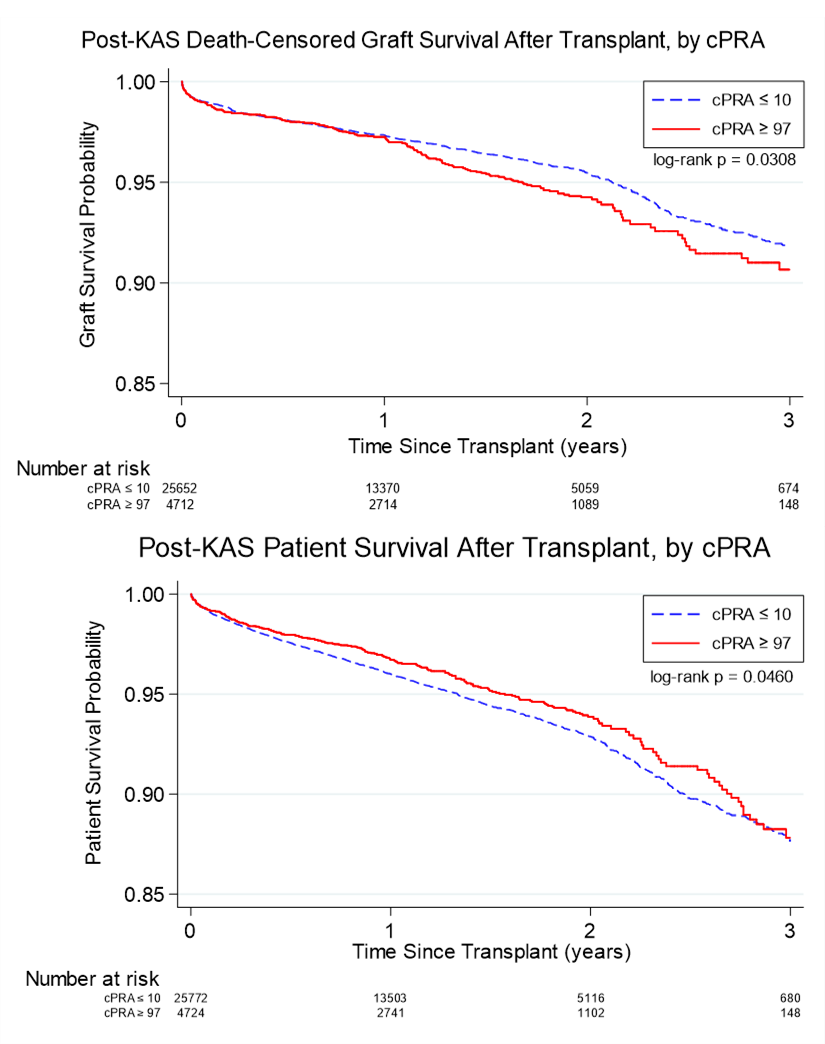Unos Analysis Of Deceased Donor Renal Transplant (ddrtx) Outcomes In Sensitized Patients After Implementation Of The Kidney Allocation System (kas)
Columbia University Irving Medical Center, New York, NY
Meeting: 2019 American Transplant Congress
Abstract number: 423
Keywords: Allocation, Kidney transplantation, Outcome, Sensitization
Session Information
Session Name: Concurrent Session: Kidney Deceased Donor Allocation III
Session Type: Concurrent Session
Date: Tuesday, June 4, 2019
Session Time: 2:30pm-4:00pm
 Presentation Time: 3:42pm-3:54pm
Presentation Time: 3:42pm-3:54pm
Location: Ballroom B
*Purpose: Introduction of KAS in 2014 prioritized access to DDRTx for highly-sensitized candidates although it was unclear whether the outcomes would be acceptable in this high immunologic risk group, many of whom have prior transplants, multiple comorbidities, and prolonged time on dialysis.
*Methods: Using the 2018 UNOS STAR file, we compared national patient and graft outcomes between high PRA (cPRA≥97%) recipients transplanted after KAS (4,726 DDRTx, 2015-2017) to low cPRA (≤10%) recipients after KAS (25,800 DDRTx, 2015-2017) and to high cPRA recipients before KAS (1,252 DDRTx, 2011-2013).
*Results: Following implementation of KAS, there has been a 3.7 fold increase in number of transplants in high PRA pts. KDPI for kidneys transplanted into high PRA patients was similar before and after KAS, though fewer patients received kidneys with KDPI >85%. EPTS at transplant was similar before and after KAS (41±48% vs 40±48%, p=0.14). Zero mismatch kidneys decreased markedly (38.29% vs 9.8%, p<0.001), and the percentage of non-white recipients increased (50.6% vs 62.5%, p<0.001). Among pts with cPRA>97%, there was no difference in death-censored graft survival before and after KAS, even after adjusting for KDPI and dialysis vintage (aHR 0.97, 0.75-1.24). Post-KAS patient survival for those with cPRA≥97% was similar to those with cPRA≤10% (aHR: 0.96, 0.84-1.11), but there was a higher adjusted rate of allograft failure at 3 years (8.1% vs 9.3%, aHR 1.29, CI 1.10-1.50, p=0.001).
*Conclusions: A stated goal of KAS was to improve access to transplant for disadvantaged individuals. We found that KAS dramatically increased the rates of transplantation in high PRA patients, particularly in non-white populations, while providing post-transplant outcomes similar to the pre-KAS era. We also found that the short term results of high PRA patient survival was indistinguishable from low PRA patients with a statistically different 3 year graft survival that is unlikely clinically significant.
To cite this abstract in AMA style:
Crew RJ, King KL, Fajardo M, Hedvat J, Lange N, Husain S, Mohan S, Ratner LE, Patel SS. Unos Analysis Of Deceased Donor Renal Transplant (ddrtx) Outcomes In Sensitized Patients After Implementation Of The Kidney Allocation System (kas) [abstract]. Am J Transplant. 2019; 19 (suppl 3). https://atcmeetingabstracts.com/abstract/unos-analysis-of-deceased-donor-renal-transplant-ddrtx-outcomes-in-sensitized-patients-after-implementation-of-the-kidney-allocation-system-kas/. Accessed December 25, 2025.« Back to 2019 American Transplant Congress

